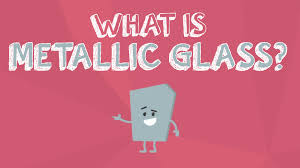What is metallic glass?

We’re well aware that most of our infrastructure is built of steel and plastic. Both of these materials have their own sets of pros and cons. Taking those into count, have you ever considered what our life would be like if we fused both of their pros? It seems like scientists have and their consideration has given rise to a new invention called metallic glass.
Contents
What are the properties of metallic glass?
Metallic glass comprises both the properties of steel and plastic in addition to some other properties as well.
- Its appearance is like that of the metals- shiny and opaque. Moreover, it is also a conductor of heat and electricity. However, it’s much stronger than metals which prevents it from getting bent. These characteristics supply for the making of ultrasharp scalpels, ultrastrong electronic cases, hinges, screws and more.
- Metallic glasses also work well for manufacturing sports equipment since they can store and release elastic energy.
- They’re resistant to corrosion.
- In a single moulding step, they can be transformed into various shapes. Exposure to high temperature softens them easily so that they can be deformed to a different shape.
How is metallic glass different from metals?
The unique characteristics of metallic glass can be attributed to the fact that its atomic structure differs from that of the metals.
In their solid-state, metals tend to be crystalline, which means that their atomic structure is coherent, uniform and orderly. Once they are heated, their atomic structure gets disturbed as well. So, the stacks of orderly fashioned atoms become dynamic and the atoms start moving around freely. Cooling them down again causes them to re-organize themselves in their former state, which in turn brings back its crystalline nature.
Metallic glass, on the other hand, works a bit differently. In their case, it seems like the cooling down process was hurried to such an extent that the atoms weren’t able to find their former positions. The resulting material is definitely a solid, but its atomic structure is rather chaotic and similar to that of an amorphous structure. This structure doesn’t have boundaries like the metals have.
How is metallic glass made?
In 1960, the first metallic glass was created using gold and silicon. Metal atoms crystallize quickly so scientists had to cool down the alloy at a very high rate by shooting droplets at cold copper plates or spinning ultrathin ribbons.
Newer discoveries have led scientists to blend several metals that are compatible with each other in such a way that they don’t crystallize together. Due to their varying atomic sizes their crystallization takes longer than usual. Therefore, it doesn’t require to be cooled down fast and the resulting mixture is much thicker than the older versions produced. These are then called BMGs i.e. Bulk Metallic Glasses.
So, one might ask as to why they’re not used for infrastructure building if they’re better than metals.
The thing is, the individual components of these BMGs are in fact very expensive, which is why it isn’t feasible to use them for building bridges etc. Plus, despite being resistant, they’re not strong enough to withstand larger weights as bridges do so, which becomes an added risk factor.






Responses